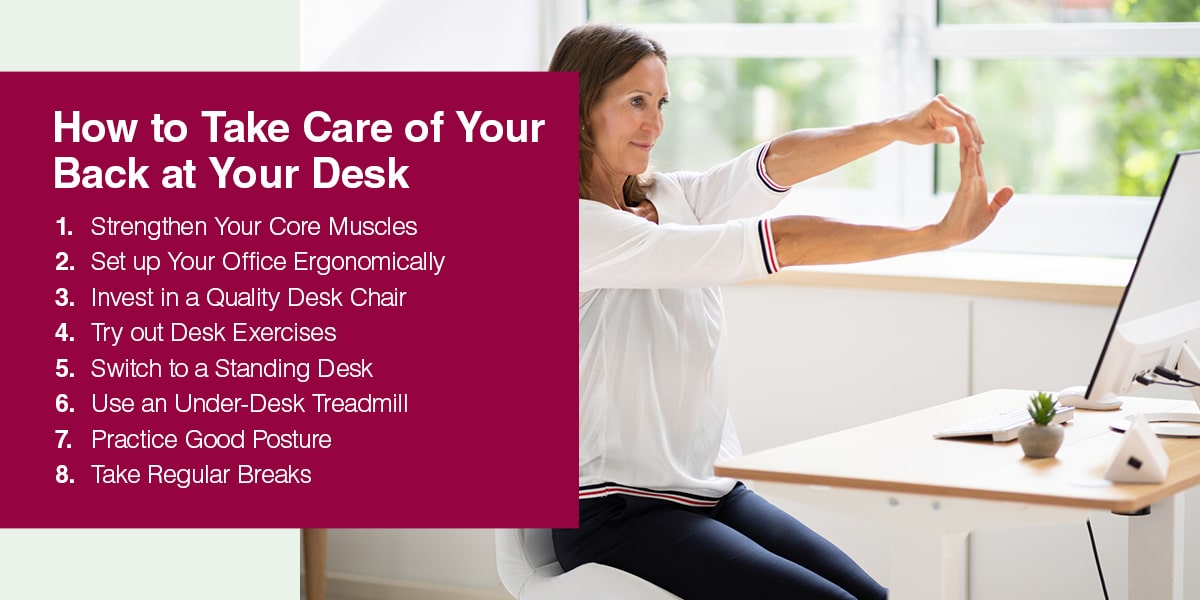8 Ergonomic Tips for Taking Care of Your Back While Working at a Desk
8 Ergonomic Tips for Taking Care of Your Back While Working at a Desk

Working an office job that involves extended periods of sitting can contribute to an unhealthy lifestyle. In addition to the many risks inactivity can pose to your well-being, sitting for too long can result in back pain.
Fortunately, you can take steps to support your back. Keep your spine happy and healthy with our ergonomic tips for working at a desk.
Table of Contents
The Impact of Being Sedentary
A sedentary lifestyle is dangerous to your health. It can contribute to the development of the following adverse health conditions:
- Obesity
- Heart disease
- Cancer
- Diabetes
- High blood pressure
- Stroke
- High cholesterol
- Joint pain
- Osteoporosis
- Depression and anxiety

How to Take Care of Your Back at Your Desk
Extended periods of sitting, combined with improper posture and ergonomics, can wreak havoc on your spine, resulting in back pain. Fortunately, you can mitigate the risks of an inactive job by incorporating the following tips for sitting at a desk into your day.
1. Strengthen Your Core Muscles
Your abdominal muscles play a significant role in supporting your back. Strong core muscles absorb some of the force and stress of movement, so your spine doesn’t have to do all the work. They also help you balance, avoid awkward movements and protect against strains.
A healthy core means better spinal and postural support. Strengthen yours by incorporating core work into your exercise routine at least three times a week. Many movements target your abdominal muscles, such as planks and crunches. Ask a trainer or physical therapist to show you the correct form for core exercises.
2. Set up Your Office Ergonomically
If you work at an office, you’ve likely heard of ergonomics, or the science of structuring a workplace to the user’s needs. An ergonomic workspace increases efficiency and productivity while minimizing discomfort. Below are a few ergonomic tips for working at your desk.
- Chair: Adjust your chair so your feet rest flat on the floor and your knees align with or are slightly below your hips. Position the armrests to relax your shoulders, and set the backrest to a slightly reclined angle. Another tip for supporting your back at your desk is to sit with your hips as far back in the chair as possible.
- Keyboard: Your keyboard should be at or slightly below elbow height and parallel to your forearms. Wrists should be in a neutral position while typing.
- Monitor: Your monitor should sit directly in front of you and your keyboard, with the top third at your seated eye level.
- Phone: People commonly cradle a phone between their shoulder and ear to free their hands to take notes, but this habit can strain the neck and upper spine. If you need to use your hands while talking on the phone, try using speakerphone or a headset.
3. Invest in a Quality Desk Chair
You spend a large part of your workday seated, so you should support your back by investing in a thoughtfully designed desk chair. A high-quality work chair should have the following features:
- Adjustable seat height, backrest and armrests
- A seat with adequate width and depth
- Lumbar support
- A swivel seat
- Cushioning
4. Try out Desk Exercises
You can perform a few effective movements at your desk to ease muscle tension if it occurs.
- Pelvic tilt: Loosen your back muscles by doing rounds of pelvic tilts. Shift your pelvis back and forth while seated, rounding and arching your lower back.
- Buddha stretch: The Buddha stretch relieves strain in your wrists. Place your palms together in front of your chest with your fingers pointing upward in a prayer position. Keep your palms together and allow your elbows to move outward as you lower your hands toward your lap.
- Chin tuck: Release a tight neck by sitting upright with a straight spine and jutting your chin forward as much as possible. Reverse the movement by slowly sliding your head back as far as possible, as if recoiling from something. Keep your head level throughout the exercise.
5. Switch to a Standing Desk
A standing desk lets you break up your day into periods of sitting and standing. Many standing desks are adjustable, so you can raise yours to a comfortable height and lower it when you’re ready to sit.
Below are a few ways a standing desk might benefit you:
- Decrease blood sugar levels
- Lower your risk of weight gain and heart disease
- Reduce lower back pain
6. Use an Under-Desk Treadmill
Upgrade your workspace by placing a treadmill under your desk. Treadmill or walking desks are an excellent way to stay active while you work. You can complete many tasks while walking on a treadmill, such as Skype calls, web research, phone calls and emails. With some practice, you can even type and handwrite while walking.
Treadmill desk speeds are for slow- to regularly paced walking, not running, so they aren’t loud enough to distract or disturb co-workers. If you opt for a treadmill desk, make it your goal to use it every half-hour, even if only for five minutes, to add some movement to your workday.
7. Practice Good Posture
It can be challenging to maintain proper posture when sitting at a desk for hours on end, but doing so can help protect your lower back from strain, pain and injury.
Slumping back in your chair or hunching forward can misalign your spine, putting pressure on the muscles and ligaments in your back. Instead, sit up straight and tall with your weight evenly distributed in your seat and your shoulders back.
8. Take Regular Breaks
Aim to get up from your desk and move around at least every hour. It can be as simple as standing up, reaching your arms to the ceiling and folding forward to graze your toes a few times. If you have a few minutes and want to change your surroundings, walk around your office building or outside to get some fresh air. Anything that gets your blood flowing and your body moving will help keep stiffness and tension at bay.
Contact Upper Cervical Chiropractic of Monmouth for Support
White-collar workers play a crucial role in our workforce, but the job’s sedentary nature can adversely affect your health, leading to back and neck pain. If you have an office job, we hope you’ll use our ergonomic tips for desk work to counteract the harmful effects of extended sitting. For more information or to discuss gentle chiropractic care for pain management, contact Upper Cervical Chiropractic of Monmouth today.





